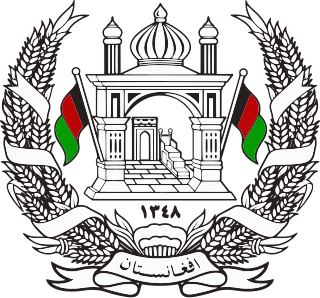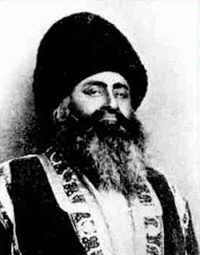Related Research Articles

Abdur Rahman Khan also known by his epithets, The Iron Amir, was Amir of Afghanistan from 1880 to his death in 1901. He is known for uniting the country after years of internal fighting and negotiation of the Durand Line Agreement with British India.

European influence in Afghanistan has been present in the country since the Victorian era, when the competing imperial powers of Britain and Russia contested for control over Afghanistan as part of the Great Game.

Badakhshan is a historical region comprising parts of modern-day north-eastern Afghanistan, eastern Tajikistan, and Taxkorgan Tajik Autonomous County in China. Badakhshan Province is one of the 34 provinces of Afghanistan. Much of historic Badakhshan lies within Tajikistan's Gorno-Badakhshan Autonomous Region in the southeastern part of the country. The music of Badakhshan is an important part of the region's cultural heritage.
Related to 1896 in Afghanistan: Negotiations are going on between the Indian government and the amir tending to the appointment of a joint commission for determining the last 100 miles (160 km) of Indo-Afghan frontier yet unsettled, from Landi Kotal in the Khyber to Nawar Kotal on the Kunar River.

The Second Anglo-Afghan War was a military conflict fought between the British Raj and the Emirate of Afghanistan from 1878 to 1880, when the latter was ruled by Sher Ali Khan of the Barakzai dynasty, the son of former Emir Dost Mohammad Khan. The war was part of the Great Game between the British and Russian empires.

Sir Henry Mortimer Durand was a British diplomat and member of the Indian Civil Service. He is best-known as the namesake for the Durand Line, which serves as the international border between Afghanistan and Pakistan.

The Panjdeh Incident was an armed engagement between the Emirate of Afghanistan and the Russian Empire in 1885 that led to a diplomatic crisis between Great Britain and the Russian Empire regarding the Russian expansion south-eastwards towards the Emirate of Afghanistan and the British Raj (India). After nearly completing the Russian conquest of Central Asia, the Russians captured an Afghan border fort, threatening British interests in the area. Seeing this as a threat to India, Britain prepared for war but both sides backed down and the matter was settled diplomatically. The incident halted further Russian expansion in Asia, except for the Pamir Mountains, and resulted in the definition of the north-western border of Afghanistan.

The Treaty of Gandamak officially ended the first phase of the Second Anglo-Afghan War. Mohammad Yaqub Khan ceded various frontier areas as well as Afghanistan's control of its foreign affairs to Britain.

The Battle of Kandahar, 1 September 1880, was the last major conflict of the Second Anglo-Afghan War. The battle in southern Afghanistan was fought between the British forces under command of General Roberts and the Afghan forces led by Ayub Khan. It ended with a British victory.

Faiz Muhammad Kāteb also known as Kāteb (کاتب) was a writer and historian. He was Afghan court chronicler, a skilled calligrapher and secretary to Habibullah Khan from 1901 to 1919.
The following lists events that happened during 1898 in Afghanistan.
The following lists events that happened during 1904 in Afghanistan.

The Barakzai dynasty also known as the Muhammadzai dynasty ruled modern day Afghanistan from 1823 to 1978 when the monarchy ended de jure under Musahiban Mohammad Zahir Shah and de facto under his cousin Sardar Mohammad Daoud Khan. The Barakzai dynasty was established by Dost Mohammad Khan after the Durrani dynasty of Ahmad Shah Durrani was removed from power. As the Pahlavi era in Iran, the Muhammadzai era was known for its progressivist modernity in which Afghanistan was referred to as the "Switzerland of Asia".
The Nasher are a noble Afghan family and Khans of the Pashtun Kharoti (Ghilji) tribe. The family is originally from Qarabagh, Ghazni but founded modern day Kunduz in the early 20th century and lived there until the end of the Barakzai dynasty in the late 20th century.
There was a small community of Armenians centered in Kabul, Afghanistan.
The Afghan Boundary Commission was a joint effort by the United Kingdom and the Russian Empire to determine the northern border of Afghanistan. The Boundary Commission traveled and documented the northern border area during 1884, 1885, and 1886.

The 1888–1893 Hazara uprisings or genocide and displacement of Hazaras occurred in the aftermath of the Second Anglo-Afghan War when the Afghan Emirate signed the Treaty of Gandamak. Afghan Amir Abdur Rahman set out to bring the Turkistan, Hazaristan, and Kafiristan regions under his control. He launched several campaigns in the Hazarajat due to resistance to oppression from the Hazaras, culminating in the Battle of Uruzgan and he conducted a widespread genocidal campaign against its population.
Saad-ud-Din, later Kazi Saad-ud-Din Khan, was a politician in Afghanistan under Abdur Rahman Khan and Habibullah Khan; he was, for a time, Habibullah Khan's father-in-law. He was the Governor of Herat for eighteen years, between 1887 and 1904, and he became the Chief Justice in 1914. He was bestowed the title "Khan e Ulum", which translates to "Master of Knowledge".
The Afghan Civil War was fought from 9 June 1863 to January 1869. It began as a result of Dost Mohammad Khan's death on 9 June 1863 and the subsequent power struggles among his sons. Dost Mohammad consolidated his power in the second half of his reign within his inner family. His sons were appointed governors of provinces and effectively acted autonomous from the central government. This would inevitably lead to his sons fighting for control after his death.

The Shaghasi are, alongside the Seraj and Telai, a prominent and powerful cadet-branch of the Afghan royal family. They belong to the Zirak branch of the Durrani confederacy, and are primarily centered around Kandahar. They can also be found in other provinces throughout central Afghanistan.
References
- ↑ Salisbury, Robert (2020). William Simpson and the Crisis in Central Asia, 1884-5. ISBN 978-1-5272-7047-3
- ↑ Yate, Arthur (1886). England and Russia Face to Face in Asia: Travels with the Afghan Boundary Commission. pp. 157, 217.
- ↑ Simpson, William (2 Feb 1885). "With the Afghan Boundary Commission". Illustrated London News. p. 217.
- ↑ Adamec, Ludwig (1975). Who's Who of Afghanistan (PDF). Austria. p. 229.
{{cite book}}: CS1 maint: location missing publisher (link)